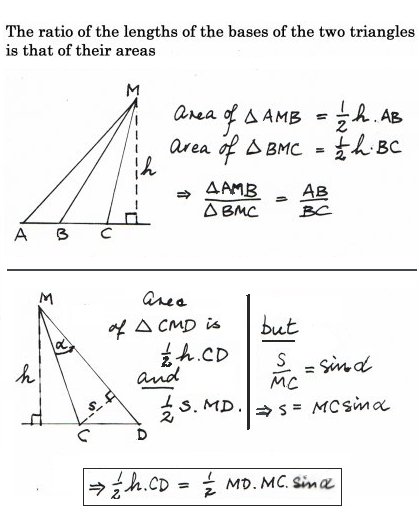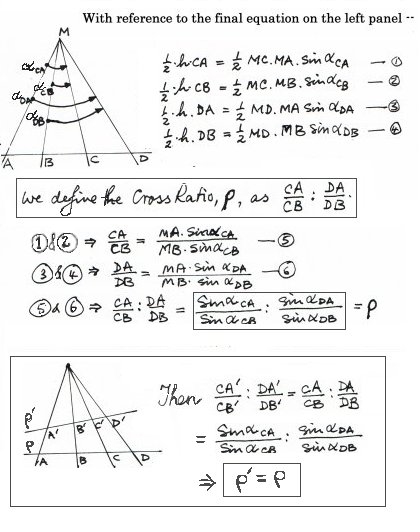On the Algebra of Measure
(2) Perspective measure
(3) Geometric measure
(4) "Growth" measure
Allowing Euclidean Absolutes, we have —

The Cross Ratio
(On the Algebra of Measure)
When a range of points on one line is projected from a point into another range on another line, metric quantities, such as length, or angle, are not preserved from range to range, simply because, for pure projective geometry, which takes cognisance only of elementary incidence, there are no such quantities to preserve!
However, if it is insisted, with Euclid, that intervals can be defined as a sum of equal units, then under the terms of that definition, it is possible to assign numerical sizes to the intervals between points, and then to use standard Euclidean/Analytic ‘geometry’. It is found that –
a ratio of ratios, or "Cross Ratio", of any three such intervals is preserved (i.e. is constant) under projection from range to range.
As this (also in its dual form) is the only metric quality to be preserved under projection, Arthur Cayley and Felix Klein were moved to use a form of it actually to define distance, and with it a metric, for projective geometry.
It will be appreciated that this was a curious and possibly redundant thing to do, because they already had distance - from Euclid - and had indeed used it (albeit embedded in the notion of "area") to establish the invariance of cross ratio in the first place—that is, they used distance to get distance. Did they blunder, or were they privy to a deeper truth?

For intervals a, b and c on one line projecting into A, B and C respectively on another line, we may, for example, write
[a/(b+c)]/[(a+b)/c] = [A/(B+C)]/[(A+B)/C]
A Euclidean/analytic proof, using area and trigonometry, of this result is given in the panels to the left and right.
There is of course no
elementary geometric proof.
Area entails Euclidean Absolutes:
- ‘equal’ distances and ‘equal’ angles
- special, ‘right’ angles.
Allowing Euclidean Absolutes, we have —

This demonstrates that
Cross Ratio is preserved under central projection.
We stress again that this is true only under the
assumption, tacit for Euclidean Geometry, that ratios of
lengths can altogether be formed.
However,
Lengths are not available to Projective Geometry,
so neither are ratios of them.